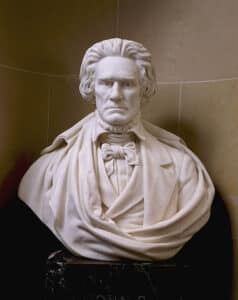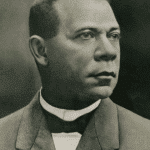While preparing for the APUSH exam, there are lots of historical figures who you should know. Many of them, such as Abraham Lincoln, you probably know pretty well. Others, however, might be unfamiliar to you. John Caldwell Calhoun might be one of these historical figures for you. As such, here are some John C. Calhoun APUSH review facts you should know.

Who is John C. Calhoun?
John C. Calhoun started as a farmer. He graduated from Yale at the top of his class, and he went on to became a lawyer. Then, he served as a Congressman, the Secretary of War for James Monroe, Secretary of State for John Tyler and James K. Polk, and the Vice President to John Quincy Adams and Andrew Jackson. Later, he resigned as the Vice President to serve as a senator.
John C. Calhoun was a member of the Great Triumvirate. He, along with two other statesmen, received this nickname for the way they dominated American politics during their time. During his time in Congress, John C. Calhoun was one of the War Hawks in the War of 1812. He also supported Henry Clay’s American System, which called for an increase in tariffs to support the American economy.
John C. Calhoun was important because he was a champion of states’ rights. He led the idea of nullification. This idea stated that each state should decide if a law is constitutional or not. If not, the state could determine if the law was null and void.
What are some key years in John C. Calhoun’s life?
- Born March 18, 1782 and died March 31, 1850
- U.S. House of Representatives: March 4, 1811 – November 3, 1817
- U.S. Secretary of War: December 8, 1817 – March 4, 1825
- Vice President: March 4, 1825 – December 28, 1832
- U.S. Secretary of State: April 1, 1844 – March 10, 1845
- U.S. Senator (South Carolina): November 26, 1845 – March 31, 1850
What are some important events John C. Calhoun was part of?
- Tariff of 1828: Known as the “Tariff of Abomination”, Congress passed the tariff on May 19, 1828. Southern states felt that it hurt their economy since it taxed imported goods.
- South Carolina Exposition: In 1828, South Carolinians protested the Tariff of 1828. They threatened succession, which led to the Doctrine of Nullification written by John C. Calhoun.
- Tariff of 1832: Congress passed the Tariff of 1832 to reduce the Tariff of 1828 and hopefully put an end to protests.
- Nullification Crisis: South Carolinians continued to protest the Tariff of 1828 and 1832. Finally, Andrew Jackson sent military forces to end the protests.
Which other historical figures were associated with John C. Calhoun?
- James Monroe: He was the 5th President of the United States. He served from 1817 to 1825. His presidency was known as the Era of Good Feelings. In addition, he negotiated the Louisiana Purchase.
- John Quincy Adams: He was the son of former President John Adams, and he served as the 6th President of the United States. When he lost re-election to Andrew Jackson, he went back to serving as a U.S. Senator.
- Andrew Jackson: After he led the victory of the Battle of New Orleans during the War of 1812, he became a war hero. His popularity helped him become the 7th President of the United States. Also, he shaped the modern Democratic Party to what it is today.
- Daniel Webster: He was the leader of the Whig Party. Then, he served as the Secretary of State for 3 presidents. He was a persuasive speaker, and he was a member of the Great Triumvirate with Henry Clay and John C. Calhoun.
- Henry Clay: Not only was he one of the members of the Great Triumvirate, but he led the War Hawks during the War of 1812. He served as a Congressman in the U.S. House of Representatives and the U.S. Senate for Kentucky. He also served as the Secretary of State and invented the American System.
What are some example John C. Calhoun APUSH questions?
1. During the South Carolina Exposition, John C. Calhoun argued for what?
A. States’ rights
B. Decreased tariffs
C. Peace between the states
D. Abolishing slavery
Answer: A. John C. Calhoun believed that the states should have the power to declare a law null and void if it was unconstitutional. He felt that each state should be able to decide this instead of the federal government.
2. The Nullification Crisis came about because of:
A. the annexation of Texas during the Mexican-American War.
B. tariffs that hurt the economy and angered Southerners.
C. the Louisiana Purchase negotiated by James Monroe.
D. the legislation passed by the Great Triumvirate during the 19th century. B
Answer: B. The Nullification Crisis came about because of the Tariff of 1828. The tariffs negatively impacted Americans in the South, especially South Carolina. Because of this, South Carolina felt that the law was unconstitutional and should be null and void in their state.
3. What did Congress do to appease South Carolina over the Tariff of 1828?
A. Congress passed the Ordinance of Nullification.
B. They allowed South Carolina to secede from the Union.
C. Congress decided to send military forces to keep the peace.
D. They passed another tariff to reduce the first one.
Answer: D. To appease South Carolina over the Tariff of 1828, Congress decided to pass the Tariff of 1832. Although this reduced the amount that people would pay, it did not stop protests.
How did you do on the practice questions? As you continue to prepare for the exam by reviewing historical figures, consider creating John C. Calhoun APUSH facts with flashcards. This can help you remember which historical figure made what contribution to American history. Happy studying!



Leave a Reply